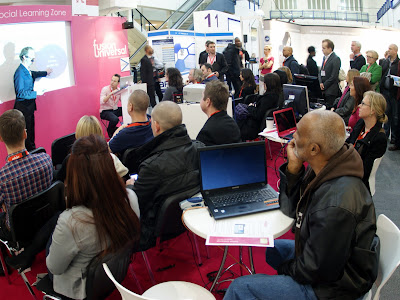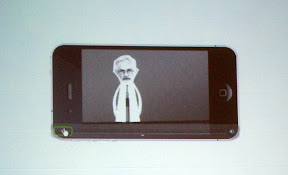Olympia is like the interior of some vast World War II Normandy Gun Emplacement – all exposed blocks of concrete, exposed pipes, clattering stairwells and distant skylights.

The catering is marginally better than that at Conference League game of football.
The layout of stands (or should I call them stalls) reminds me of an East European Department store in the early 1990s.
On registration you are handed a fat catalogue worthy of IKEA, sadly your journey around the show is anything like as smooth or as comprehensive – more like shuffling through a multi-story car-park full of baldy parked 4x4s.
The lecture ‘theatres’ are open plan and back to back; they conflict for attention. The combination of two speakers at it, never mind music from surrounding stands, obliges a ‘sit-forward and concentrate’ mentality. Imagine two noisy street shows in action simultaneously on the cobles of Covent Garden.
Stalls, not stands, was the behaviour too of some selling their services, with leaflets thrust into your hands and conversations started that you didn’t want whether eye contact was made or not); the inclination is to make a blunt response; the danger is that you soon find yourselves burdened with the equivalent of every Sunday newspaper in one go.
There was a hint of desperation about some of it.
None of this is conducive to enjoyment or appropriate for a showcase of e-learning technology 2011.
Despite this I’m preparing to return for a second day.
_______________________________________
I attended with a producer from E-Learning Productions. I go wearing three hats: producer of content, learning manager wannabe and Open University MA student in his 'second year' of Open and Distance Education - starting H800 around now (I think the virtual gates to the module open on the 27th).
The quality of the Learning Technologies presentations (with one exception) and the stands that we chose, rather than chose us, was impressive.
Much of it rings true, reinforcing our views on where we feel the market is going, this was especially the case with the Video Arts presentation ‘Video learning: anywhere, anytime and just in time.’
Blog entries below indicate where and why I think video will take over from print; this was demonstrated by Video Arts.

Drawing on a back catalogue of high quality, humour and drama-based learning Video Arts have created a digital platform that allows users to pick ‘n mix clips to assemble a learning programme of their own.
These ‘chunks’ of ‘stuff’ make a bespoke learning programme.
I question how ‘right way, wrong way’ illustrated with humour always works, wondering if the humour and the performance is recalled, but the message lost. Which is why I’d expect all learning to be measured for effectiveness, the brutal answers of success or failure being the test of a good learning programme.
Emerging challenges in learning: proving the business value answered any concerns or interest I might have in gauging effectiveness.
Though competing with presentation immediately behind in Theatre 2, Jeff Berk delivered an insightful, packed, brutally stark means to measure the effectiveness of training.

Jeff's background as an auditor showed, but my creative head said that whatever ways or means of communicating ideas, of sharing knowledge and experience, of teaching, of learning, that I may devise or select ‘off-the-shelf’ or from one of these ‘stalls,’ www.Knowledgeadvisors.com will tell me if it worked or not, if not why not, if so where so, and what to change and how.
An invaluable service that must form the part of any learning and training programme budget.
The thread of the presentation, that felt like an attempt to run through the contents of Wikipedia in 30 minutes, was that Training Managers should ‘replace the smile sheet, with the smart sheet.’
I buy that.
Jeff spoke of ‘improving human capital performance.'
I like the idea of ‘sensitivity analysis’ and ‘action metrics’ helping the learning consultant in a business discussion identifying actual rather than perceived problems to get a fix.

I take away too the idea of ‘Scrap Learning’ and ‘Pointers for Change,’ as well as ‘Actionable Metrics,’ a ‘dashboard of summarised information for senior managers.
Had I been to Learning Technologies the week before rather than a week before a job interview I wonder if the outcome would have been different?
This stuff matters, and now I know it.
Jeffrey Berk is quotable; it is corporate speak at its best. ‘Leverage methodology into the spirit of the technology,’ he said.
There’s a White Paper ‘Standard Reports of the Future’ that you can request by email Jeff the COO of Knowledge Advisors on jberk@knowledgeadvisors.com.
Leadership for the 21st Century and how to achieve it was a dreary, ill-considered Slide Show read out by a presenter who I sensed hadn’t seen the slides until the moment they appeared on the wall behind him. He read, verbatim from notes, his head buried in the lectern.

No introduction, just started reading as if someone had put 50p in a Juke Box.
The best demonstration of how to present badly I have ever witnessed and after two minutes I was desperate to escape.
Mercifully what was billed as 30 minute presentation barely lasted 10.
The clichéd jigsaw piece analogy, the lengthy self-quoting of the long dead American who devised the programmed smacked of an attempt to sell 1970s fashioned Moon Boots at a desert oasis.
Fusion Learning have a theatre-cum-stand.

They compete successfully with the hubbub and take the idea of the market stall to its obvious corporate conclusion. It would be unfair to say that Steve Dineen was selling product out the back of a lorry, but the simple lay-out of stand as platform, replete with headset and microphone suggested something of this ilk. Though no visitor to a street market is going to be sitting in front of a laptop, watching an interactive presentation and receiving a back massage.

Quotes can be scattered around a presentation like baubles on an over-decorated Christmas tree, but this one from Einstein worked in this context.
‘Everything should be made as simple as possible, but not simpler.’ Albert Einstein.
Fusion Universal take an idea that is a decade old and do it better.
How to animation on Microsoft Product delivered via a searchable ‘just in time format.’
For example, I can’t get my head around the plethora of choices regarding headers and footers in the new word package. Type, search, click and I get a voiced animation of how to do it. A decade ago I bought this kind of thing on a CD-ROM for £75, today I take out an annual subscription, select from a multitude of bite-size ‘info drops’ and may even contribute my own ‘how to ‘ clips should I think I have a fix, a better fix, or an alternative fix or just fancy myself as a presenter, voice over artists and director/writer of video-based assets.

Like Steve, I too change into ‘soft shoes’ when faced with being on my feet all day.
Had I a budget this alone would have had me signing up to their services.
He wore sheepskin moccasins. I think if all delegates left their shoes at registration and padded around in slippers or socks it would be conducive to a far more chilled atmosphere.
walk around the lanes in Brighton and you will come across many of the organisations presenting here; Epic, Kineo, Edvantage and Brightwave are four that come to mind. Perhaps these organisations should band together to bring customers to them on the Brighton Seafront; or does Wired Sussex does this already? __________________________________________________________________________________
Naomi Norman introduced Epic beginning with a reminder of their impactful, PR coup, the annual e-learning debate in the Oxford Union.
This is a non-Oxford event, despite the implied cache, that uses the debating chamber ahead of the academic year.
It attracts interest, not least to Epic’s LinkedIn E-learning forum that I find a constant stream of intelligent, current thinking, or as Naomi put it, ‘good, memorable, engaging interactions.’

The presentation in relation to mobile learning is succinctly expressed as:
‘Learning in the moment, Learning across space and learning across time.’
We saw highly simplified 2d animations that mixed a bit of silent movie text and Captain Pugwash paper-cut outs to give gobbets of information on First Aid. More at www.firstaid.co.k (free download).

Also some of the 20 hours of materials, 4 hours of it video, for Collins for whom Epic have turned an entire two years GCSE Maths Curriculum into a smart phone App.
My colleague and I debated some of the more confusing visuals for this course on the way home and reckoned our children would only engage with the content if they had to, and would probably try to cram it all in the day before an exam. i.e. parents become tutors and facilitators, somehow having to cajole some interest in engagement early on, with rewards for completion of modules.
The idea that a book will teach a 13 year old something, let alone a game like platform, ignores the fact that in isolation this kind of self-directed learning doesn’t happen without the outside influence of schools, parents and most especially peer pressure.
Marcus Boyes clicked through a mobile learning website developed by Epic.
It was a convincing demonstration of how rapidly a complex task that may have taken many months, can be compressed into a few weeks, leaving content creators to compose. I liken it to an conductor having an assembled brass band with players who can play and instruments that work, rather than finding you have to first make the instruments and then learn how to play them.
Go compose.
Far from farting about (as he put it) I found Marcus informed, engaged, practical and agile. He is the perfect tech savvy person, passionate about what he does and mindful of the need to make things easy. I want to go home and 'make an App' myself. In fact, with a shelf of 4,000 charts, 400 photos and about 10,000 words the Skieasy Books I took to Collins in 1991 may yet find their way into publication.
I can see virtue in going straight to Mobile application.
If it works in this format then you’ve got something write, as Einstein desires, you’ve made it simple. Then you get all the gains of being mobile, engaging the learning any moment in the day when they have downtime.
There’s a White Paper. Stand 54. Or from Epic’s website.Or from me now that I'vedownloaded it.

Go register. They're worth it.
And this App for LinkedIn from EIPC looks useful.

I like these papers, but sometimes question their academic validity.
A white paper pre-supposes peer review and scrutiny in an academic setting. Has this happened? I let my OU colleagues take a view. If published in a reputable journal I'd buy it.
Go see.
Much more on Video Arts to follow.